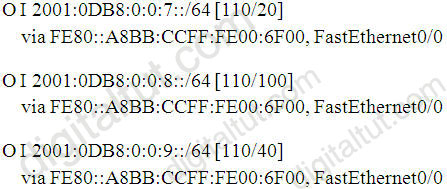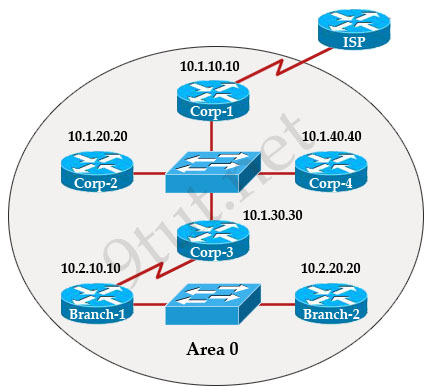ICND2 – OSPF Questions
[am4show have=’p2;’]
Premium Member: You can test your knowledge with these questions first via this link.
[/am4show]
Question 1
[am4show have=’p2;’]What are two drawbacks of implementing a link-state routing protocol? (Choose two)
A. the sequencing and acknowledgment of link-state packets
B. the requirement for a hierarchical IP addressing scheme for optimal functionality
C. the high volume of link-state advertisements in a converged network
D. the high demand on router resources to run the link-state routing algorithm
E. the large size of the topology table listing all advertised routes in the converged network
Answer: B D[/am4show]
Question 2
[am4show have=’p2;’]Which two statements describe the process identifier that is used in the command to configure OSPF on a router? (Choose two)
Router(config)# router ospf 1
A. All OSPF routers in an area must have the same process ID.
B. Only one process number can be used on the same router.
C. Different process identifiers can be used to run multiple OSPF processes
D. The process number can be any number from 1 to 65,535.
E. Hello packets are sent to each neighbor to determine the processor identifier.
Answer: C D[/am4show]
Question 3
[am4show have=’p2;’]What are three characteristics of the OSPF routing protocol? (Choose three)
A. It converges quickly.
B. OSPF is a classful routing protocol.
C. It uses cost to determine the best route.
D. It uses the DUAL algorithm to determine the best route.
E. OSPF routers send the complete routing table to all directly attached routers.
F. OSPF routers discover neighbors before exchanging routing information.
Answer: A C F[/am4show]
Explanation
OSPF is a link-state routing protocol so it converges more quickly than distance-vector protocol. OSPF uses cost to determine the best route. The popular formula to calculate OSPF cost is: cost = 108 / Bandwidth [ in bps] (in fact the formal formula is: cost = reference bandwidth / configured bandwidth of interface in kbps. On Cisco routers, the reference bandwidth defaults to 100000 kbps)
Question 4
[am4show have=’p2;’]Which two statements about the OSPF Router ID are true? (Choose two)
A. It identifies the source of Type 1 LSA
B. It should be the same on all routers in an OSPF routing instance
C. By default, the lowest IP address on the router becomes the OSPF router ID
D. The router automatically chooses the IP address of a loopback as the OSPF Router ID
E. It is created using the MAC Address of the loopback interface
Answer: A D[/am4show]
Explanation
From the output of the “show ip ospf database”:

We can see OSPF Router ID will be used as source of Type 1 LSA (1.1.1.1 & 2.2.2.2). Also the router will chose the highest loopback interface as its OSPF router ID (if available).
Question 5
[am4show have=’p2;’]What are two enhancements that OSPFv3 supports over OSPFv2? (Choose two)
A. It requires the use of ARP.
B. It can support multiple IPv6 subnets on a single link.
C. It supports up to 2 instances of OSPFv3 over a common link.
D. It routes over links rather than over networks.
Answer: B D[/am4show]
Explanation
Unlike OSPFv2 which form adjacencies using their IPv4 interface addresses, OSPFv3 use the link-local addresses (FE80::/10) to form adjacencies. Therefore it can support multiple IPv6 subnets on a single link as an interface can have multiple IPv6 addresses (and two nodes can communicate with each other even if they do not share a common IP subnet.) -> B is correct.
IPv6 uses the term “link” instead of “subnet” or “network” to define a medium used to communicate between nodes at the link layer -> D is correct.
OSPFv3 can support more than 1 instance over a common link. For example you can run instance 1 on an interface with the command:
Router(config-if)# ipv6 ospf 100 area 0 instance 1
-> C is not correct.
Question 6
[am4show have=’p2;’]You enter the “show ipv6 route” command on an OSPF device and the device displays a route. Which conclusion can you draw about the environment?
A. OSPF is distributing IPv6 routes to BGP.
B. The router is designated as an ABR.
C. The router is designated as totally stubby.
D. OSPFv3 is in use.
Answer: D[/am4show]
Explanation
The “show ipv6 route” displays the current contents of the IPv6 routing table. This device is running OSPF so we can deduce it is running OSPFv3 (OSPF for IPv6). An example of the “show ip v6 route” is shown below:

Question 7
[am4show have=’p2;’]What are OSPF default hello and dead timers? (Choose two)
A. The hello timer is 10 seconds.
B. The hello timer is 60 seconds.
C. The dead timer is 40 seconds.
D. The dead timer is 120 seconds.
E. The hello timer is 20 seconds.
Answer: A C[/am4show]
Explanation
By default, OSPF uses a 10-second hello timer and 40-second hold (dead) timer on broadcast and point-to-point links, and a 30-second hello timer and 120-second hold timer for all other network types.
Question 8
[am4show have=’p2;’]Refer to the exhibit. Router edge-1 is unable to establish OSPF neighbor adjacency with router ISP-1. Which two configuration changes can you make on edge-1 to allow the two routers to establish adjacency? (Choose two)

A. Set the subnet mask on edge-1 to 255 255.255.252.
B. Reduce the MTU on edge-1 to 1514.
C. Set the OSPF cost on edge-1 to 1522.
D. Reduce the MTU on edge-1 to 1500.
E. Configure the ip ospf mtu-ignore command on the edge-1 Gi0/0 interface.
Answer: D E[/am4show]
Explanation
In order to become OSPF neighbor following values must be match on both routers:
+ Area ID
+ Authentication
+ Hello and Dead Intervals
+ Stub Flag
+ MTU Size
Therefore we need to adjust the MTU size on one of the router so that they are the same. Or we can tell OSPF to ignore the MTU size check with the command “ip ospf mtu-ignore”.
Question 9
[am4show have=’p2;’]Which commands are required to properly configure a router to run OSPF and to add network 192.168.16.0/24 to OSPF area 0? (Choose two)
A. Router(config)# router ospf 0
B. Router(config)# router ospf 1
C. Router(config)# router ospf area 0
D. Router(config-router)# network 192.168.16.0 0.0.0.255 0
E. Router(config-router)# network 192.168.16.0 0.0.0.255 area 0
F. Router(config-router)# network 192.168.16.0 255.255.255.0 area 0
Answer: B E[/am4show]
Explanation
In the router ospf command, the ranges from 1 to 65535 so o is an invalid number -> B is correct but A is not correct.
Question 10
[am4show have=’p2;’]Refer to the exhibit.

The internetwork infrastructure of company XYZ consists of a single OSPF area as shown in the graphic. There is concern that a lack of router resources is impeding internetwork performance.
As part of examining the router resources the OSPF DRs need to be known.
All the router OSPF priorities are at the default and the router IDs are shown with each router.
Which routers are likely to have been elected as DR? (Choose two)
A. Corp-1
B. Corp-2
C. Corp-3
D. Corp-4
E. Branch-1
F. Branch-2
Answer: D F[/am4show]
Explanation
There are 2 segments on the topology above which are separated by Corp-3 router. Each segment will have a DR so we have 2 DRs.
To select which router will become DR they will compare their router-IDs. The router with highest (best) router-ID will become DR. The router-ID is chosen in the order below:
+ The highest IP address assigned to a loopback (logical) interface.
+ If a loopback interface is not defined, the highest IP address of all active router’s physical interfaces will be chosen.
In this question, the IP addresses of loopback interfaces are not mentioned so we will consider IP addresses of all active router’s physical interfaces. Router Corp-4 (10.1.40.40) & Branch-2 (10.2.20.20) have highest “active” IP addresses so they will become DRs.


Are there any OSPF IPv6 questions on current 200-125 or 200-105 exams?
Question 8 – Why is answer A not the one of the right answers?
routers exchange routing information on layer two. If you noticed the routers IP addresses aren’t even in the network 10.0.0.0/31. You’re right to think of the network connectivity but the question is more about what needs to match between two routers to form an OSPF adjacency.
Dear Smartin, do a lap for question for question 8, you will see that the 2 neighbors must be in the same subnet. A also should be one of the correct answers
Dear Joseph, A can never be one of the correct answer because 255.255.255.252 is /30 and the subnet mask in this question is /31 or 255.255.255.254.
Q3 explanation needs correction.
OSPF cost= 10000 0000/bandwith in bps. Not kbps
https://www.cisco.com/c/en/us/support/docs/ip/open-shortest-path-first-ospf/7039-1.html#t6
@Bengt: Thanks for your information, we updated that explanation.
I cant see the questions… Just answers and explanations
@nag, you need a paid account to see questions.
@Malcolm, where can I get the 398q dumps?
Q5- in reading RFC 5340 section 2.4 states ” OSPF now supports the ability to run multiple OSPF protocol instances on a single link.
So how is C not correct?
Q9- is confusing. can’t figure out how 0.0.0.255 is calculated
Answer was E. Router(config-router)# network 192.168.16.0 0.0.0.255 area 0